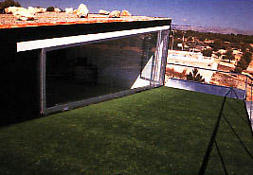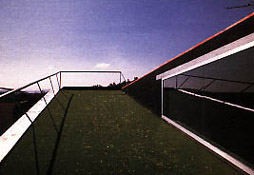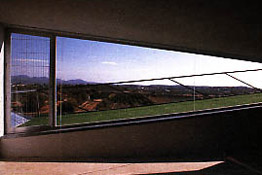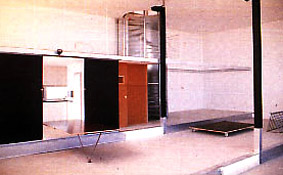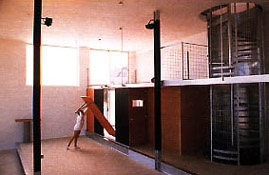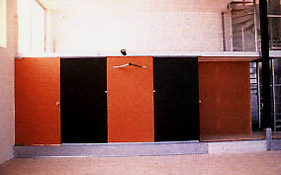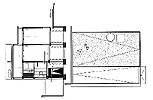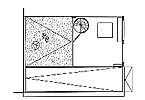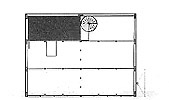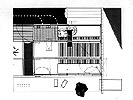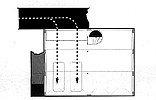| [1] |
Integración con el
paisaje |
|
El análisis del paisaje y de sus
elementos naturales son el origen del proyecto, igual que el de una calle o una trama
urbana lo es en la ciudad. Todo el solar merece un proyecto, por acción o por omisión.
La construcción de la vivienda es un proceso naturalmente artificial o artificialmente
natural. Vivienda y paisaje se integran en una nueva unidad. |
| [2] |
Alta calidad a bajo coste |
|
Se debe conseguir el máximo con
lo mínimo. El dinero es un bien escaso en nuestro tiempo. Hay que optimizar los recursos
disponibles. La belleza de un edificio no viene dado por la calidad de sus materiales sino
por sus cualidades espaciales. La calidad es un problema de moral. De precisión. De
actitud ante el proceso constructivo que depende de todos los que participan en este mismo
proceso, desde el cliente hasta el último industrial. |
| [3] |
Concentración, con el
aprovechamiento máximo |
|
La acumulación y la
concentración permiten optimizar recursos en el funcionamiento de un edificio o de una
ciudad, frente a la dispersión, que requerirá permanentemente recursos para permitir su
funcionamiento (energia, movimiento....). Cualquier material del lugar (rocas, tierra,
agua, aire....) cualquier energía urbana, es susceptible de integrarse en el proyecto a
coste cero. |
| [4] |
Materiales artificiale |
|
La industria ofrece materiales
cada vez más inteligentes a un precio menor. Materiales que mantienen sus propiedades y
su efecto en los espacios independientemente de la época del año, de la hora del día.
Materiales que requieren un mantenimiento prácticamente nulo. |
| [5] |
Movilidad del espacio
interior |
|
Las viviendas son grandes
espacios vacíos ocupados por objetos móviles que permiten realizar actividades en ese
espacio. Objetos inteligentes, multifuncionales en ocasiones, que convierten todo el
interior en un mueble. Se habita un mueble. |
| [6] |
Límites inteligentes |
|
Los espacios vacíos
monomateriales tienen límites inteligentes conseguidos con un fino espesor: aluminio,
maderas, bloques, vidrio. En las fachadas el vidrio está compuesto por diferentes
láminas que responden a cada caso con protección térmica, solar, antirrobo, y que
permiten el grafiado de imágenes y texturas. La reconstrucción del suelo, sobre el
terreno artificial, se hace insertando instalaciones de electricidad, agua, calefacción
que aportarán el confort necesario al espacio habitable. |
| [7] |
Los usos se desarrollan
en la sección |
|
El subsuelo, introducido en la
tierra, y la cubierta, en contacto con el cielo, son espacios a utilizar con la misma
intensidad que el nivel del terreno natural. A partir de una forma simple en planta, el
edificio, la ciudad se organiza mediante la superposición de capas que poseen una
naturaleza propia. El recorrido del edificio se produce por medio de rampas, escaleras,
como si de un paseo se tratara. |
| [8] |
La medida del espacio |
|
Cantidad es calidad. Cada uso
necesita un espacio de un tamaño determinado. La vivienda se organiza por medio del
contraste entre tamaños de espacios. No existe una altura estándar, ni una medida
estándar. Altura, anchura y longitud generosos al servicio de la calidad. |
|
| [1] |
Integration into the landscape |
|
The study of the landscape and its natural
elements is the origin of the design, just as the study of a street or an urban fabric is
in the city. The whole site deserves a design, by action or by omission. The construction
of the dwelling is a process that is naturally artificial or artificially natural.
Dwelling and landscape are integrated in a new unity. |
| [2] |
High quality at a low cost |
|
One should build the maximun with the
minimum. Money is always a scarce commodity nowadays. One must optimise the resources at
hand. The beauty of a building doesn´t come as a datum with the quality of its materials
but by its spatial qualities. Quality is a moral issue. Of an extremely precise process.
From an attitude before the constructive process that depends on all those who participate
in this process, from the client to the last factory. |
| [3] |
Concentration with a maximum of
efficient use |
|
Accumulation and concentration allow the
optimising of resources in the functioning of a building or city, as opposed to
dispersion, which permanently requires resources to allow it to function (energy,
movement...). Any material in the place (rocks, dirt, water, air...), any urban energy,
are susceptible to integration with the design. |
| [4] |
Artificial materials |
|
Industry offers more and more intelligent
materials at lower prices. Materials that maintain their properties and effect in spaces
regardless of season or time of day. Materials that require practically no maintainance. |
| [5] |
Mobility of interior space |
|
Dwellings are large, empty spaces occupied
by mobile objects that allow activities to be performed in that space. Intelligent
objects, multifunctional at times, that convert the whole interior into a piece of
furniture. We live in furniture. |
| [6] |
Intelligent limits |
|
Empty, mono-material spaces have
intelligent limits reached with a fine thickness: aluminium, wood, blocks, glass. In the
façades glass is composed of different laminates that respond in each case with thermal,
solar an burglary protection, and it allows the graphing of images and textures. The
reconstruction of the floor, over the artificial terrain, is done by inserting
electricity, water and heating systems that provide the necessary comfort to the habitable
space. |
| [7] |
The uses are developed in section |
|
The sub-floor, cut into the earth, and the
roof, in contact with the sky, are spaces to be used with the same intensity as the level
of the natural terrain. Starting with a simple form in plan, the building, the city is
organised through the superimposition of layers that have their own nature. The trajectory
of the building is produced via ramps, stairs, as if it concerned a single hall. |
| [8] |
The size of the space |
|
Quantity is quality. Each use requires a
space of a given size. The dwelling is organised by means of the contrating sizes of
spaces. There is no standard height, nor standar measure: but ample height, width and
length at the service of quality. |
|
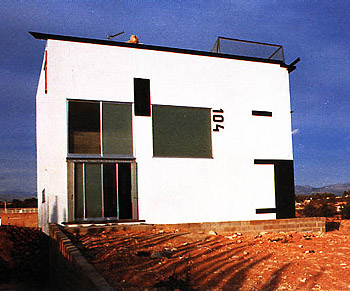
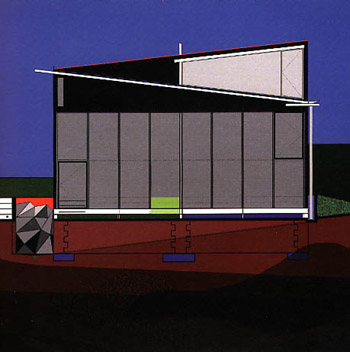
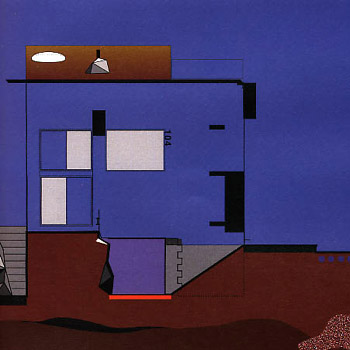
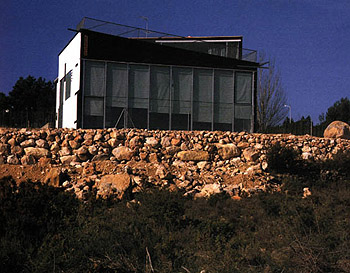
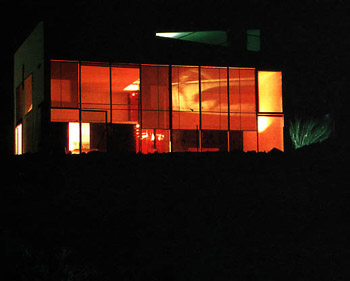
|
ENTREVISTA AL
PROPIETARIO
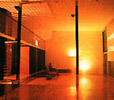
CLIENTE: Quisiera
tener una casa grande. De niño vivía en una casa convencional, con un salón en L y una
pequeña habitación desde la que se oía la televisión constantemente. Ahora me
gustaría disfrutar de un gran espacio, muy alto, con mucha luz y pocos muebles. La
habitación estará en la planta superior, mirando hacia las montañas.
ARQUITECTO: Es una
buena idea.
C: Además quisiera
tener un jardín, con árboles y flores, con pista de tenis y piscina, pero no quisiera
tener que cuidarlo, como hacía mi padre con su pequeño huerto.
A: Lo haremos todo
artificial. Césped de plástico, árboles de hierro, montañas artificiales con la tierra
excavada, flores con luces de colores... No será un proyecto "consolatorio".
C: Pero el
presupuesto del que dispongo es muy bajo.
A: Lograr el máximo
de calidad a un bajo coste es un buen reto. Construiremos un edificio noble partiendo de
materiales sencillos.
C: ¿Cómo lo
conseguirás?
A: La casa será dura
y confortable; abstracta y natural simultáneamente. |
INTERVIEW WITH THE CLIENT
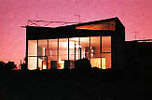
CLIENT: I´d like to have a
big house. When I was little, I lived in a conventional house, with an L-shaped
living room and small bedroom where I could never get away from the sound of the
television. Now I´d like to have a large space, with high ceilings, lots of light and not
very much furniture. The bedroom will be on the top floor, looking towards the mountains.
ARCHITECT: That´s a good
idea.
C: I´d also like a garden,
with trees and flowers, with a tennis court and swimming pool, but I don´t want to have
to look after it, like my father did with his little garden.
A: We´ll make it all
artificial. Plastic lawn, iron trees, artificial mountains with the earth dug away,
flowers with coloured lights... It won´t be a "consolation" project.
C: But I´ve fot a very small
budget.
A: Getting the best in quality
at a low price is a great challenge. We´ll build a noble building out of simple
materials.
C: And how will you manage
that?
A: The house will be hard and
comfortable; abstract and natural at the same time. |
